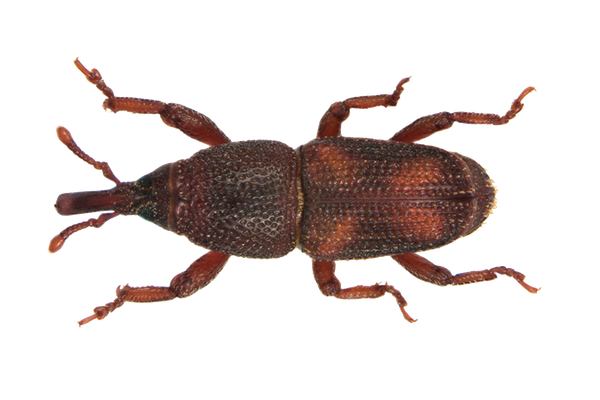| Description | Adult is 2–4 mm in length with a long snout. Varies from reddish-brown to nearly black with four light reddish or yellowish spots on its back. They rarely fly, but adults climb well even on non-porous, vertical surfaces (e.g. glass). |
|---|---|
| Distribution | Cosmopolitan, established in all regions except the coolest temperate regions. In Australia, this pest occurs in all grain-growing regions. |
| Pest status | Major, widespread, regular. A primary internal feeding pest of stored grain. Particularly abundant in warm countries, where it breeds continuously thorough the year. |
| Host range | A major pest of whole cereal grains but also infests cereal products such as pasta. |
| Damage | Larval feeding leaves large cavities inside grain and emerging adults leave large emergence holes. Adults feed on whole and damaged grains and large numbers generate heat and moisture, encouraging mould growth and mites, both of which reduce grain quality. |
| Risk period | All year. |
| Life cycle | Adult weevils live 4–5 months, occasionally up to 2 years. Each female lays 300–400 eggs. Before laying the egg, the female uses its mandibles to chew a small hole in the grain kernel, then deposits one egg in the hole and covers it with a gelatinous fluid. The small white larva burrows into the kernel excavating a cavity as it grows, and transforms into a pupa before emerging as an adult. The total development from egg to adult takes about 26 days at optimal conditions of 30ºC and 70% relative humidity but this period is greatly prolonged during cold weather (15 weeks at 18°C, development stops below 15°C). |
| Means of protection |
Cultural control – The insect does not occur in standing crops. Therefore, good hygiene with storage and handling equipment should minimise infection. Prevention treatment by Methograin Delta IGR Grain Protectant is the primarily recommended product for prevention. To gain the widest possible range of protection Methograin Delta IGR Grain Protectant together with Methograin Fenitrothion 1000 can be applied. Chemical control – In case of infestation, fumigation in sealed storage. |
